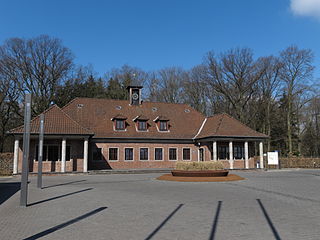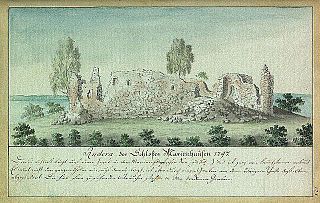
Neustadt am Rübenberge is a town in the district of Hannover, in Lower Saxony, Germany. At 357 km2 (138 sq mi), it is the 9th largest settlement in Germany by area, though only about 45,000 inhabitants live there. It is in a region known as the Hanoverian Moor Geest.
The Democratic Forum of Germans in Romania is a centrist political party representing the interests of the German minority in Romania.
The Zipser Germans or Zipsers are a German-speaking ethnic group which developed in the Szepes County of Upper Hungary—today mostly Slovakia—as that region was settled by people from central Germany beginning in the 13th century. Beginning in at least the 18th century, many members of the ethnic group migrated to southern Bukovina, Maramuresch, and Transylvania. Former Slovak President Rudolf Schuster is partly Zipser German.

The Yurlov Crower is an old Russian breed of chicken primarily selected and used for long crowing cock contests in Russia.

Lehnin Abbey is a former Cistercian monastery in Lehnin in Brandenburg, Germany. Founded in 1180 and secularized during the Protestant Reformation in 1542, it has accommodated the Luise-Henrietten-Stift, a Protestant deaconesses' house since 1911. The foundation of the monastery in the newly established Margraviate of Brandenburg was an important step in the high medieval German Ostsiedlung; today the extended Romanesque and Gothic brickstone buildings, largely restored in the 1870s, are a significant part of Brandenburg's cultural heritage.

The Poltava is an old Ukrainian dual-purpose breed of chicken named after the Ukrainian city of Poltava. It includes three color varieties: Clay, Cuckoo, and Black.

The Bukovina Germans are a German ethnic group which settled in Bukovina, a historical region situated at the crossroads of Central and Eastern Europe. Their main demographic presence lasted from the last quarter of the 18th century, when Bukovina was annexed by the Habsburg Empire, until 1940, when nearly all Bukovina Germans were resettled into the Third Reich as a part of Heim ins Reich national socialist population transfer policy.
This is a list of German language place names in Poland, now exonyms for towns and villages in the Pomeranian Voivodeship.
The Friedrich Loeffler Institute (FLI), is the National Institute for Animal Health of Germany, that country's leading animal disease center. The institute was founded in 1910 and named for its founder Friedrich Loeffler in 1952. The FLI is situated on the Isle of Riems, which belongs to the City of Greifswald. Riems is a very small island that can be reached via a dam, which can be closed off in case of an outbreak. Due to these circumstances, Riems posed the perfect location for one of the most modern animal health research facilities in the world.

The Federal Agricultural Research Center (FAL), headquartered in Braunschweig, was a federal authority of the Federal Ministry of Food, Agriculture and Consumer Protection. On January 1, 2008, FAL was split into the Johann Heinrich von Thünen Institute, the Julius Kuehn Institute and the Friedrich Loeffler Institute.

Przywidz is a village in Gdańsk County, Pomeranian Voivodeship, in northern Poland. It is the seat of the gmina called Gmina Przywidz.

Viļaka Castle is a castle in the historical region of Latgale, in eastern Latvia. The castle is located close to Viļaka town, on an island in the Viļaka Lake. Built by Archbishopric of Riga in 1342 as a wooden castle, rebuilt as a stone castle after 1516. The castle was destroyed in 1702 during the Great Northern War. The outer walls are 1.6m thick, remaining fragments of the walls are up to 2 meters high.

The County of Wölpe was the territorial lordship of a noble family in the Middle Ages in the Middle Weser Region near Nienburg/Weser which folded in 1302. The seat of the counts of Wölpe was the castle site at Erichshagen-Wölpe on the Wölpe stream in the borough of Nienburg in north Germany. The castle itself no longer exists.

John I, Margrave of Brandenburg was from 1220 until his death Margrave of Brandenburg, jointly with his brother Otto III "the Pious".
Otto III, nicknamed the pious was Margrave of Brandenburg jointly with his elder brother John I until John died in 1266. Otto III then ruled alone, until his death, the following year.

John II, Margrave of Brandenburg-Stendal was co-ruler of Brandenburg with his brother Otto "with the arrow" from 1266 until his death. He also used the title Lord of Krossen, after a town in the Neumark.
The Kloster Mariensee is an Evangelical Lutheran women's convent in Mariensee, a district of Neustadt am Rübenberge close to Hanover. It is one of five Calenberg Convents, which are administered by the Klosterkammer Hannover.
The Hermann von Nathusius Medal was endowed in 1928 by the German Society for Animal Breeding (DGfZ) in memory of Hermann Engelhard von Nathusius, an important German breeder. It is awarded, usually annually, to those who have excelled in the area of animal breeding, or in the production branch. [1]
The Asmari is a large breed of goat originating in the Kunar province of Afghanistan. They are a general purpose breed, and are mainly used as pack animals and grown for their meat and milk. They are well adapted to local conditions, making them an important livestock resource for local farmers.
The Klosterkammer Hannover, based in Hanover, is a special authority within the scope of the Lower Saxony Ministry of Science and Culture. It administers former ecclesiastical, mediatized property and maintains churches and convents. In addition, as a foundation body (Stiftungsorgan), it administers four independent foundations under public law.











